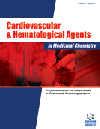- Home
- A-Z Publications
- Cardiovascular & Hematological Agents in Medicinal Chemistry (Formerly Current Medicinal Chemistry - Cardiovascular & Hematological Agents)
- Previous Issues
- Volume 7, Issue 3, 2009
Cardiovascular & Hematological Agents in Medicinal Chemistry (Formerly Current Medicinal Chemistry - Cardiovascular & Hematological Agents) - Volume 7, Issue 3, 2009
Volume 7, Issue 3, 2009
-
-
The No-Reflow Phenomenon in the Coronary Circulation
More LessThe no-reflow phenomenon is a poorly understood complication of percutaneous coronary intervention in which diminished blood flow to distal microvascular beds persists despite the successful treatment of the occlusive lesion from the epicardial coronary artery or arteries. In this contemporary review we endeavour to discuss the pathophysiology of coronary no-reflow, understand the predictors and describe curre Read More
-
-
-
Anticoagulation in Patients with Heart Failure
More LessAuthors: R. S. Bhatia, Maral Ouzounian, Jack V. Tu, Peter P. Liu and Douglas S. LeeThe decision to anti-coagulate patients with heart failure (HF) is a difficult one, with limited data available to support clinical judgment. Thromboembolic complications, both arterial (stroke) and venous (deep vein thrombosis and pulmonary embolism), remain a significant cause of mortality and morbidity in this population. The pathophysiology of thrombogenesis in HF may be contextualized in the classic triad of sta Read More
-
-
-
Optimal Management of Hypertension in patients with Ischemic Heart Disease
More LessAuthors: Debabrata Mukherjee and Charles L. CampbellEpidemiological studies suggest a strong association between hypertension and ischemic heart disease (IHD), and hypertension is a major independent risk factor for the development of cardiovascular disease (CVD) including myocardial infarction (MI) and stroke. The primary objective of the management of hypertension in patients with IHD is modification of the balance between myocardial oxygen supply and demand Read More
-
-
-
Phosphodiesterase 3 (PDE3): Structure, Localization and Function
More LessAuthors: Taku Murata, Kasumi Shimizu, Kenichi Hiramoto and Toshiro TagawaCyclic adenosine 3'5'-monophosphate (cAMP) and cyclic guanosine 3'5'-monophosphate (cGMP) are critical intracellular messengers involved in transduction of signals generated by a wide variety of extracellular stimuli, including growth factors, cytokines, peptide hormones, light and neurotransmitters. These messengers modulate many fundamental biological processes, including myocardial contractility, platelet agg Read More
-
-
-
Current Pharmacological Approach to Restore Endothelial Dysfunction
More LessEndothelial dysfunction is characterized by an impairment of endothelium-dependent vasodilatation. It has been linked to each of the known atherogenic risk factors, including diabetes mellitus, hypertension, dyslipidaemia, cigarette smoking, menopause, etc. A number of recent studies have shown that the severity of endothelial dysfunction correlates with the development of coronary artery disease and predicts future Read More
-
-
-
Respiratory Syncytial Virus (RSV) Prevention and Treatment: Past, Present, and Future
More LessRespiratory syncytial virus (RSV) is a very important pathogen worldwide. It occurs and recurs naturally throughout life. Both short and long term morbidity, and mortality are particularly significant for infants, especially those infants with underlying conditions and risk factors. Current treatment strategies for these patients (e.g Ribavirin) are limited but several new interventions (e.g. RSV604, BTA9881, ALN-RSV01) are Read More
-
-
-
Human Plasma Kallikrein-Kinin System: Physiological and Biochemical Parameters
More LessAuthors: J. W. Bryant and Z. Shariat-MadarThe plasma kallikrein-kinin system (KKS) plays a critical role in human physiology. The KKS encompasses coagulation factor XII (FXII), the complex of prekallikrein (PK) and high molecular weight kininogen (HK). The conversion of plasma prekallikrein to kallikrein by the activated FXII and in response to numerous different stimuli leads to the generation of bradykinin (BK) and activated HK (HKa, an antiangiogenic peptide). BK Read More
-
-
-
The C242T CYBA Polymorphism as a Major Determinant of NADPH Oxidase Activity in Patients with Cardiovascular Disease
More LessAuthors: P. Mehranpour, S. S. Wang, R. R. Blanco, W. Li, Q. Song, B. Lassegue, S. I. Dikalov, H. Austin and A. M. ZafariSingle nucleotide polymorphisms (SNP) in the CYBA gene encoding p22phox have been associated with respiratory burst and cardiovascular phenotypes. We previously reported a reduced phagocytic respiratory burst activity in healthy adults with the C242T SNP, but found no correlation between CYBA SNPs and coronary artery disease (CAD) phenotype. Using lymphoblastoid cells, we hypothesized that CYBA SNPs affect e Read More
-
Volumes & issues
-
Volume 23 (2025)
-
Volume 22 (2024)
-
Volume 21 (2023)
-
Volume 20 (2022)
-
Volume 19 (2021)
-
Volume 18 (2020)
-
Volume 2 (2020)
-
Volume 17 (2019)
-
Volume 16 (2018)
-
Volume 15 (2017)
-
Volume 14 (2016)
-
Volume 13 (2015)
-
Volume 12 (2014)
-
Volume 11 (2013)
-
Volume 10 (2012)
-
Volume 9 (2011)
-
Volume 8 (2010)
-
Volume 7 (2009)
-
Volume 6 (2008)
-
Volume 5 (2007)
-
Volume 4 (2006)
Most Read This Month
Article
content/journals/chamc
Journal
10
5
false
en


